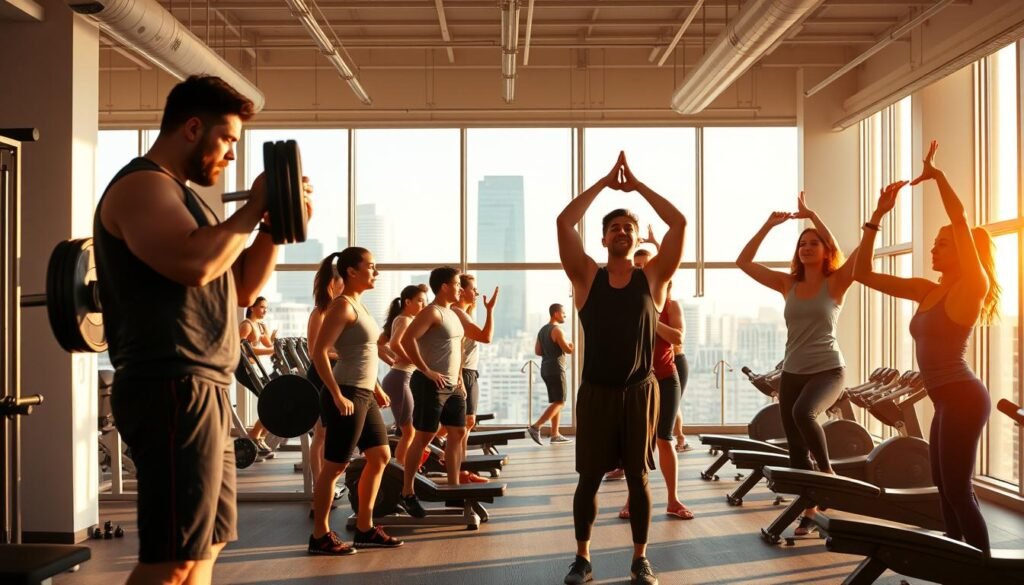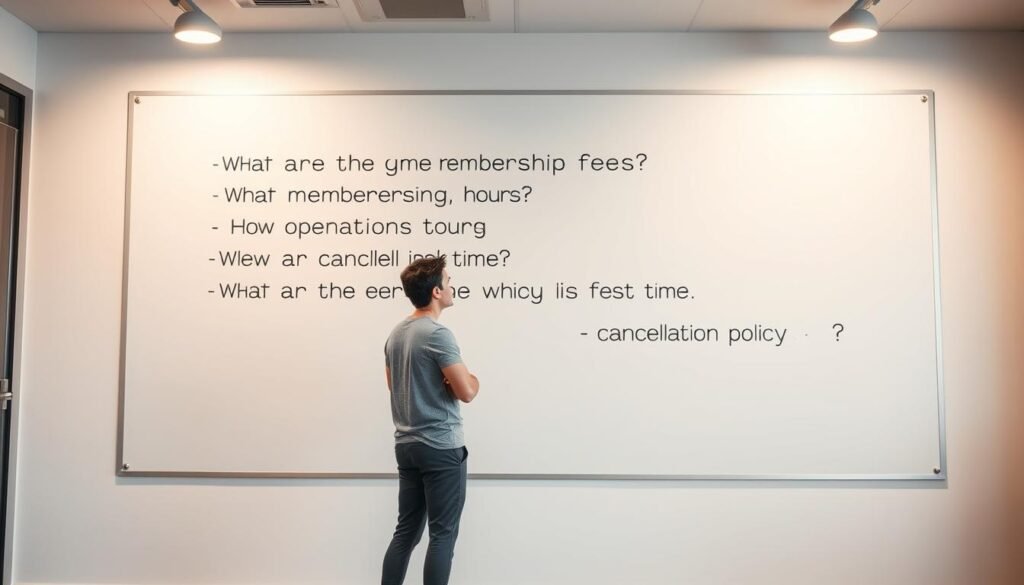Did you know nearly 76% of gym-goers quit within a year? This is often because their fitness goals don’t match the gym they chose. The right workout environment can boost your motivation and improve your exercise experience.
Finding the right gym is more than just a place to lift weights. It’s about discovering a space that energizes you, fits your schedule, and supports your goals. This article will help you find the perfect gym for your needs and help you reach your fitness goals.
Key Takeaways
- Understanding your fitness goals is key to choosing the right gym.
- The ideal gym should match your schedule and energize your workouts.
- It’s important to research the gym’s facilities and services.
- Think about the gym’s atmosphere and community to boost your motivation.
- Don’t forget to check the gym’s location and hours of operation.
Defining Your Fitness Goals and Workout Preferences
Your fitness journey starts here: defining your goals and preferences. To achieve your fitness goals, you first need to identify what those goals are. Whether it’s weight loss, muscle building, or improving flexibility, understanding your primary fitness objectives is key.
Identifying Your Primary Fitness Objectives
It’s essential to pinpoint what you want to achieve through your workout routine. This could range from improving overall health to preparing for a specific athletic event.
Weight Loss and Cardio Goals
For those focusing on weight loss and cardio, the emphasis is on burning calories and improving cardiovascular health. Activities like running, cycling, and swimming are excellent options. As noted by fitness expert, “Cardio is king when it comes to burning fat and improving heart health.”
Muscle Building and Strength Training
If your goal is muscle building and strength training, you’ll want to focus on resistance exercises. This includes weight lifting and bodyweight exercises that help in building muscle mass and increasing overall strength.
Flexibility and Wellness Objectives
For individuals aiming at flexibility and overall wellness, practices like yoga and Pilates are highly beneficial. They help in improving flexibility, balance, and reducing stress.
Assessing Your Current Fitness Level
Understanding your current fitness level is vital. It helps in creating a realistic workout plan. You can assess your fitness level by considering factors like your current activity level, health status, and any physical limitations.
Determining Your Workout Style and Schedule
Your workout style and schedule should align with your lifestyle and preferences. Whether you’re a morning person or prefer evening workouts, your gym schedule should fit your routine. Consider your availability and preferred workout duration when planning your fitness regimen.
By defining your fitness goals and understanding your workout preferences, you’re taking the first step towards a successful fitness journey. Remember, your goals should be specific, measurable, achievable, relevant, and time-bound (SMART) to ensure you’re on the right track.
Types of Gyms and Their Specializations
When looking for a gym, it’s key to know the different types and what they offer. The fitness world has grown to meet many needs and goals. This means there are many places to choose from, each with its own special features.
Traditional Commercial Gym Chains
Traditional gym chains are well-known and easy to find. They have a wide range of equipment and amenities.
Equipment Variety and Amenities
These gyms have lots of cardio and strength-training gear. You’ll find:
- Treadmills and ellipticals
- Free weights and resistance machines
- Functional training areas
Amenities include locker rooms, showers, pools, and sometimes saunas or nutrition advice.
Typical Membership Structures
Membership plans vary. You can choose from month-to-month or annual contracts. Some gyms have different membership levels, giving you more or less access.
Boutique Fitness Studios and Specialized Facilities
Boutique studios focus on specific workouts or groups. They offer a more personal experience. Think yoga, Pilates, or dance classes.
CrossFit Boxes and Functional Training Centers
CrossFit boxes are all about intense, functional workouts. They have:
- Open workout areas with functional equipment
- Group classes with varied, intense workouts
- A community feel
24-Hour Fitness Centers and Budget Options
24-hour gyms are great for those with odd schedules. Budget gyms offer basic equipment and facilities at a lower cost.
Women-Only and Demographic-Specific Gyms
Some gyms are for specific groups, like women-only. These places offer a comfortable space for those who prefer a more personal experience.
Knowing about the different gym types and what they offer helps you choose the right one. It’s all about finding a gym that fits your fitness goals and preferences.
Researching Gyms Near Me: Location and Accessibility
When looking for a gym, its location is key. A gym too far from home or work can make it hard to stick to your routine. This can lead to missing workouts.
Determining Optimal Distance from Home or Work
The gym’s distance from your daily spots matters a lot. Aim for a gym within a 10 to 15-minute drive or a 30-minute walk. This makes it easier to fit in a workout.
Evaluating Parking and Public Transportation Options
Think about parking and public transportation when picking a gym. A gym with good parking or easy access by bus or train is more convenient. Gyms near public transport hubs are also a plus.
Analyzing Hours of Operation and Peak Times
The gym’s hours of operation and peak times are important. Make sure it’s open when you like to work out. Avoid gyms too crowded during your preferred times to use the equipment you need.
Using Gym Finder Apps and Online Resources
Use gym finder apps and online tools to find gyms near you. These can give you details on location, amenities, and membership. Apps from big gym chains and fitness websites are good resources.
| Feature | Ideal Gym | Your Gym |
|---|---|---|
| Distance from Home/Work | 10-15 minute drive | |
| Parking/Public Transport | Ample parking or near public transport | |
| Hours of Operation | Aligns with your schedule |
By looking at these factors, you can find a gym that fits your life. This makes it easier to reach your fitness goals.
“The right gym is not just about the equipment; it’s about finding a place that fits your lifestyle and keeps you motivated.”
Evaluating Gym Equipment and Facility Quality
When choosing a gym, it’s important to check the equipment and facilities. The quality and variety of equipment are key. Also, the cleanliness and maintenance of the gym are vital.
Essential Equipment for Different Workout Types
Different workouts need different equipment. Look for gyms with a variety of machines and tools. This ensures a well-rounded gym experience.
Cardio Machine Variety and Condition
A good gym has many cardio machines. These include treadmills, ellipticals, and stationary bikes. Make sure these machines are modern and well-kept.
Free Weights and Strength Training Equipment
For strength training, gyms should have free weights and machines. This includes dumbbells, barbells, and resistance machines.
Cleanliness Standards and Maintenance Protocols
A clean gym is healthier and safer. Look for gyms with clear cleanliness standards and regular maintenance.
Additional Amenities Worth Considering
Some gyms offer extra amenities that can improve your workout. These can make your gym experience better.
Pools, Saunas, and Recovery Facilities
Amenities like pools, saunas, and recovery facilities are great. They help with recovery and relaxation.
Locker Rooms and Shower Quality
Clean locker rooms and showers are important. They make your gym experience more comfortable. Look for gyms that focus on these areas.
Here’s a comparison of key gym features to consider:
| Feature | Basic Gym | Premium Gym |
|---|---|---|
| Cardio Equipment | Treadmills, Bikes | Treadmills, Bikes, Ellipticals, Rowing Machines |
| Strength Training | Free Weights, Basic Machines | Free Weights, Advanced Machines, Cable Systems |
| Additional Amenities | Locker Rooms, Showers | Locker Rooms, Showers, Pool, Sauna, Recovery Facilities |
By carefully evaluating gym equipment and facility quality, you can choose a gym that meets your fitness goals. It should also provide a comfortable and motivating environment.
Understanding Gym Membership Options and Pricing
It’s important to understand gym membership pricing to find a plan that fits your budget and fitness goals. Gyms offer different membership plans to meet various needs and preferences.
Comparing Monthly vs. Annual Membership Plans
Gyms usually have monthly or annual plans. Monthly plans are flexible, allowing easy changes or cancellations. On the other hand, annual plans often have discounts for longer commitments. Think about your budget and fitness goals when choosing.
Identifying Hidden Fees and Contract Terms
Don’t just look at the initial cost of gym memberships. Some gyms have hidden fees for things like personal training or locker room use. Reading the contract carefully can help avoid surprise costs.
Negotiating Rates and Seeking Discounts
Many gyms are willing to negotiate prices, even for long-term memberships. Also, ask about discounts. Some gyms offer corporate discounts for certain companies or family discounts for multiple family members.
Corporate and Family Discount Options
Corporate discounts can lower costs for employees at partner companies. Family discounts make it cheaper for several family members to join.
Seasonal Promotions and Special Offers
Gyms often have seasonal promotions or special offers to attract new members. Keep an eye out for these to save money or get extra services for free.
Utilizing Trial Periods and Guest Passes
Use trial periods or guest passes to try out a gym before joining. This ensures the gym meets your needs.
| Membership Type | Features | Cost |
|---|---|---|
| Monthly Plan | Flexible, access to all facilities | $50/month |
| Annual Plan | Discounted rate, access to all facilities | $500/year |
| Corporate Discount | Discounted membership for company employees | 10% off |
Assessing the Gym’s Culture and Community Fit
A gym’s culture and atmosphere are key to your fitness journey. The right environment can motivate you to achieve your goals. On the other hand, a bad one can hold you back.
Observing Member Demographics and Atmosphere
Look at the gym’s member demographics when you visit. Check if the age, fitness level, and vibe match what you like. A gym with diverse members might offer more workout options and social chances.

Evaluating Staff Friendliness and Professionalism
The gym staff can greatly affect your experience. See how friendly, knowledgeable, and helpful they are. Friendly and professional staff can make you feel more at home.
Analyzing Crowding During Your Preferred Workout Times
Crowding is a big factor in your gym experience. Go to the gym when you usually work out to see how busy it is. A busy gym might be overwhelming, while an empty one might lack energy.
Determining If the Gym Environment Matches Your Preferences
Choose a gym that fits your personal preferences and fitness goals. Think about what environment motivates you. Some like a lively atmosphere, while others prefer a calm setting.
By carefully looking at these factors, you can find a gym that supports your fitness needs. It should also offer a community that makes your gym experience better.
Exploring Personal Training and Class Options at the Gym
Exploring personal training and class options at your gym is key to a better workout. Personal trainers and group fitness classes offer guidance, motivation, and variety. They can really boost your workout routine.
Evaluating Personal Trainer Qualifications and Specialties
Choosing a personal trainer is important. Look for trainers certified by groups like the American Council on Exercise (ACE) or the National Academy of Sports Medicine (NASM). Make sure they have experience with clients like you.
Assessing Group Fitness Class Variety and Scheduling
Group fitness classes are great for staying motivated. Check out the variety of classes. Look for high-intensity and cardio classes, strength and resistance training classes, and mind-body and flexibility programs.
High-Intensity and Cardio Classes
High-intensity and cardio classes are perfect for improving heart health and burning calories. Try spinning, Zumba, or HIIT (High-Intensity Interval Training) classes.
Strength and Resistance Training Classes
Strength and resistance training classes build muscle and boost strength. These classes use weights, resistance bands, or bodyweight exercises.
Mind-Body and Flexibility Programs
Mind-body and flexibility programs, like yoga and Pilates, enhance flexibility, balance, and mental health.
Specialized Programs for Specific Needs
Many gyms have programs for specific needs. Look for senior fitness and rehabilitation options or beginner-friendly programs.
Senior Fitness and Rehabilitation Options
Senior fitness and rehabilitation programs are for older adults or those recovering. They focus on gentle exercises to improve mobility and strength.
Beginner-Friendly Programs
Beginner-friendly programs are great for newbies or those restarting their fitness journey. They offer a supportive setting and basic exercises.
“The right fitness class can make all the difference in achieving your fitness goals.”
By evaluating personal trainer qualifications and group fitness class variety, you can craft a workout routine that’s both effective and fun.
Essential Questions to Ask Before Joining a Gym
Joining a gym is a big step. Asking the right questions can help you avoid problems. It’s important to know the gym’s policies, services, and atmosphere. This ensures it meets your fitness needs and preferences.
Membership Flexibility and Cancellation Policies
It’s key to understand your gym membership options. Ask about cancellation policies and any penalties for quitting early. Some gyms have month-to-month plans, while others require a long-term contract. Knowing your choices is important before you sign up.
Guest Pass Policies and Membership Freezing Options
Many gyms offer guest passes for newcomers. These passes let you try out the gym before joining. Also, find out about membership freezing options. This is useful if you need to pause your membership for illness, travel, or other reasons.
Equipment Replacement and Facility Upgrade Plans
A good gym has well-kept equipment and facilities. Ask about the gym’s plans for equipment replacement and facility upgrades. A gym that keeps its equipment and facilities up-to-date will likely offer a better workout experience.
COVID-19 Protocols and Cleanliness Standards
With COVID-19, knowing a gym’s COVID-19 protocols and cleanliness standards is critical. Look for gyms with strict cleaning schedules and safety measures. This ensures a safe environment for everyone.
Additional Services and Their Costs
Many gyms offer additional services like personal training and nutrition counseling. Ask about these services and their costs. This helps you stay within your budget and meet your fitness goals.
By asking these questions, you can choose a gym wisely. This ensures your membership is both fulfilling and affordable.

Making Your Final Decision: Comparing Your Top Gym Choices
As you narrow down your gym options, a thorough comparison will ensure you choose the best fit for your fitness objectives. With your research complete, it’s time to weigh the pros and cons of each gym against your specific needs.
Creating a Comparison Checklist of Your Top Contenders
Start by creating a checklist that includes key factors such as equipment quality, group fitness class variety, and membership pricing. This will help you visualize the strengths and weaknesses of each gym.
Weighing Pros and Cons Against Your Fitness Goals
Consider how each gym aligns with your fitness goals. For instance, if you’re interested in weightlifting, look for gyms with high-quality equipment and adequate space. If group classes are your preference, evaluate the variety and scheduling of classes.
Timing Your Gym Membership Purchase Strategically
Think about the timing of your membership purchase. Some gyms offer promotions or discounts during certain periods, such as the beginning of the year or summer months.
Preparing for Your First Day at Your New Gym
Once you’ve made your decision, prepare for your first day at the gym by familiarizing yourself with the facility, packing your gym bag, and setting realistic expectations.
By following these steps, you’ll be well-prepared to make an informed decision and start your fitness journey on the right foot.
Conclusion
Finding the perfect gym is a journey that requires careful thought. You need to think about location, equipment quality, membership options, and gym culture. These factors help you choose a gym that fits your fitness goals.
When looking for a gym, consider what type you need. Look at the equipment and facilities quality. Also, think about the gym’s atmosphere, staff, personal training, and group classes.

It’s smart to make a checklist of what’s important to you. Here’s a table with some key things to consider:
| Factor | Importance Level | Notes |
|---|---|---|
| Location | High | Close to home or work |
| Equipment Quality | High | Variety and condition |
| Membership Options | Medium | Flexibility and cost |
| Gym Culture | Medium | Atmosphere and community |
By doing your research and visiting gyms, you can find the right place for your fitness journey. Remember, your fitness journey is unique. The right gym can greatly help you reach your goals.
Sources
Looking for the best gym and wanting to reach your fitness goals? Check out these fitness resources for more information.
- American Council on Exercise (ACE)
- International Dance and Fitness Association (IDEA)
- National Strength and Conditioning Association (NSCA)
These websites offer great tips on fitness training, choosing a gym, and creating workout routines. They can guide you in making smart choices for your fitness journey.
FAQ
What factors should I consider when choosing a gym?
Think about your fitness goals and what you like to do at the gym. Also, consider the gym’s location, the quality of its equipment, and membership options. Don’t forget about the gym’s culture and community.
How do I determine my fitness goals and workout preferences?
First, figure out what you want to achieve in fitness. Then, check where you are now and what you enjoy doing. Lastly, think about how often you can work out.
What types of gyms are available, and how do I choose the right one?
There are many gyms out there. You can choose from big chains, special studios, CrossFit, 24/7 gyms, or gyms for specific groups. Pick one that fits your goals and style.
How important is location and accessibility when choosing a gym?
Location and how easy it is to get there are key. Look at how close it is to your home or work. Also, check out parking and public transport options and the gym’s hours.
What should I look for when evaluating gym equipment and facility quality?
Look at the equipment you need for your workouts. Check if the gym is clean and has extras like towels and showers.
How do I compare gym membership options and pricing?
Compare monthly and yearly plans and watch out for hidden fees. Try to get a better deal by negotiating. Use trial periods and guest passes to test the gym first.
What should I consider when assessing the gym’s culture and community fit?
Look at who goes to the gym and how friendly the staff is. See if it’s busy when you usually go. This will help you decide if it’s the right fit for you.
How do I evaluate personal training and group fitness classes at the gym?
Check if the trainers are qualified and if they offer what you need. Look at the variety and times of group classes. See if they have special programs for you.
What questions should I ask before joining a gym?
Ask about changing your membership or canceling it. Find out about guest passes and when they replace equipment. Also, ask about COVID-19 rules and extra services and their costs.
How do I make my final decision when choosing a gym?
Make a list of your top gyms and their pros and cons. Think about your fitness goals. Then, pick the best time to join.
